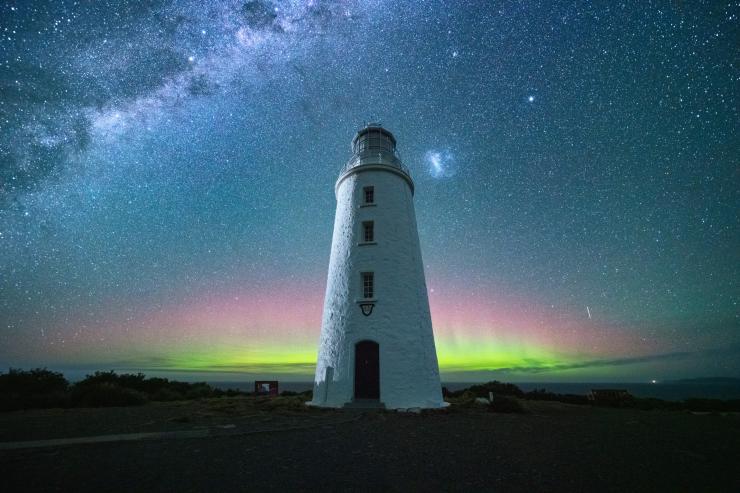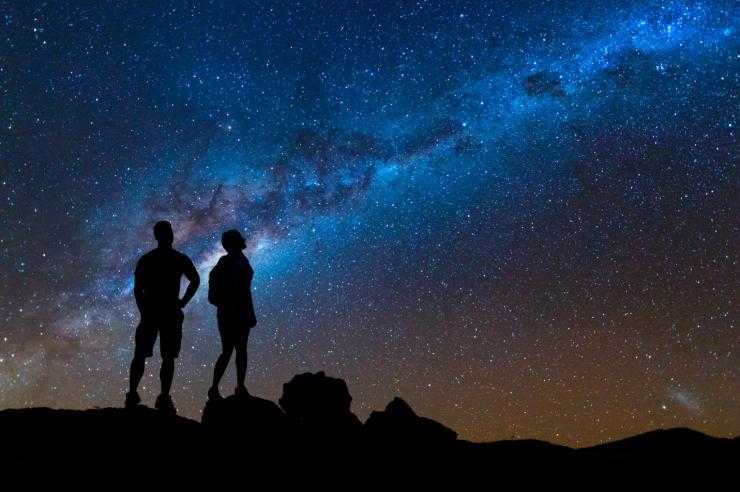
Aurora Australis, Cradle Mountain-Lake St Clair National Park, TAS © Pierre Destribats
Where to see the southern lights
Travelling in Tasmania? Keep your eyes peeled for one of nature’s most magnificent shows.
By Georgia Rickard
Like its Northern Hemisphere counterpart (Aurora Borealis), the Southern Lights (Aurora Australis) illuminate the night sky with flickering shades of green, blue, purple and red. The Southern Lights can be viewed all year round – although most commonly during winter (May to August) and during the spring equinox in September.
Your best chance of witnessing this phenomenon is to be as far south as possible – which means Tasmania. All you need for a sighting is a broad horizon (away from artificial light), a decent camera and good timing. Here are a few places to catch this flickering light show.
Bruny Island

Bruny Island, Tasmania © Luke Tscharke
“Bruny” as it’s affectionately known by Tasmanians, is a favourite weekend getaway. Just 30 minutes by car from Hobart, it is a haven for wildlife such as wedge-tailed eagles and white wallabies, and has a well-developed food scene – don’t miss the Bruny Island Cheese Co. Relatively rural, the island is free from light and city pollution (two of the biggest hindrances to seeing the Southern Lights), with the added benefit of stunning beaches and wilderness. For the best views of the Southern Lights, climb the stairs at The Neck and point your camera southwards. Southern Lights or not, the views of the island, ocean and vast, starry sky are memorable.
Satellite Island
You’d be hard-pressed to find a better location than Satellite Island. This islet just off the coast of Bruny Island was named for its excellent stargazing. In fact, one of the area’s original explorers chose Satellite Island as the place from which to map the southern skies. Once an industrial salmon farm, the 34-hectare (84-acre) isle was recently repurposed into a private luxury stay complete with kitchen gardens, 24-hour on-call concierge and a herd of black-faced sheep. You’ll need to rent the whole island to stay here (maximum occupancy is eight guests), but we’d say it’s worth it.
Cradle Mountain-Lake St Clair National Park

Cradle Mountain, Tasmania © Pierre Destribats
The main obstructions to viewing the Southern Lights include large mountain ranges and trees – which is why Cradle Mountain-Lake St Clair National Park, with its series of flat, mirrored lakes is a great backdrop for the Southern Lights. Head to the still waters of Cradle or Dove Lake and settle in for the show. You’ll be happy with or without the Southern Lights, as the park is generally regarded as one of Australia’s most beautiful, with its 60-million-year-old myrtle forests, spectacular alpine wilderness and the epic Overland Track. Stay at Peppers Cradle Mountain Lodge or the stylish Pumphouse Point, both located within the park.
Read next
Australia’s ultimate stargazing locations
Bathurst Harbour
In one of the most remote corners of the vast Tasmanian Wilderness World Heritage Area, you’ll find Bathurst Harbour – and Par Avion Southwest Wilderness Camp. This exclusive retreat is about 100km (62mi) from the nearest town and only accessible by plane then boat, so it’s a memorable place to enjoy viewing the Southern Lights. Sit on the camp’s private beach and stare up at the night sky. Afterwards, discover a hot chocolate waiting for you in your room, or perhaps order a glass of Tasmanian whisky to toast your experience.
The Central Highlands

Thousand Lakes Lodge, Central Highlands, Tasmania © Alice Hansen
The “Land of a Thousand Lakes” in Tasmania’s Central Highlands is characterised by flat, expansive plains and thousands of lakes carved out by glacial movement over millions of years. Like Cradle Mountain-Lake St Clair National Park, its unobstructed horizon views make this an ideal area for viewing the Southern Lights, especially when you can retreat to Thousand Lakes Lodge afterwards. Once an acclimatisation centre for CSIRO scientists headed to Antarctica, the lodge still offers the same hauntingly beautiful landscapes and extreme climates – but these days you’ll find a decidedly higher level of luxury in the rooms.


































































































































